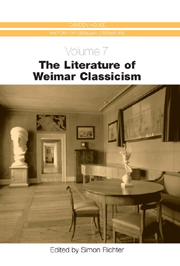Book contents
- Frontmatter
- Contents
- List of Illustrations
- Preface and Acknowledgments
- Conventions, Editions, and Abbreviations
- Introduction
- What is Classicism?
- Antiquity and Weimar Classicism
- The Correspondents' Noncorrespondence: Goethe, Schiller and the Briefwechsel
- Johann Gottfried Herder: The Weimar Classic Back of the (City)Church
- Drama and Theatrical Practice in Weimar Classicism
- German Classical Poetry
- The Novel in Weimar Classicism: Symbolic Form and Symbolic Pregnance
- German Women Writers and Classicism
- Weimar Classicism as Visual Culture
- The Irrelevance of Aesthetics and the De-Theorizing of the Self in “Classical” Weimar
- Goethe's “Classical” Science
- The Political Context of Weimar Classicism
- Bibliography
- Notes on the Contributors
- Index
Johann Gottfried Herder: The Weimar Classic Back of the (City)Church
Published online by Cambridge University Press: 05 February 2013
- Frontmatter
- Contents
- List of Illustrations
- Preface and Acknowledgments
- Conventions, Editions, and Abbreviations
- Introduction
- What is Classicism?
- Antiquity and Weimar Classicism
- The Correspondents' Noncorrespondence: Goethe, Schiller and the Briefwechsel
- Johann Gottfried Herder: The Weimar Classic Back of the (City)Church
- Drama and Theatrical Practice in Weimar Classicism
- German Classical Poetry
- The Novel in Weimar Classicism: Symbolic Form and Symbolic Pregnance
- German Women Writers and Classicism
- Weimar Classicism as Visual Culture
- The Irrelevance of Aesthetics and the De-Theorizing of the Self in “Classical” Weimar
- Goethe's “Classical” Science
- The Political Context of Weimar Classicism
- Bibliography
- Notes on the Contributors
- Index
Summary
Anyone who has become familiar with the loci of Classical Weimar can place Herder on the city map: the Herderplatz is on the open, visible side of the Stadtkirche of Saints Peter and Paul — long since, of course, renamed the Herderkirche — just off the city center, where Herder preached and is buried. The plaza is adorned with a statue of the famous man. Overshadowed by the church, on the other side, “back of ” it, as Herder often said, is the street where the parsonage is located, where Herder and his growing family lived from his arrival in Weimar in 1776 until his death in 1803. A parsonage is of course a “Dienstwohnung” — the Herders never owned any real property in Weimar, and in spite of his exalted official titles Herder was too often regarded and treated as just one of the help. After all, keeping the people properly religious was (and of course still is) often regarded as a function of the state, not just a personal vocation.
In identifying himself or talking about himself, Herder was likely to place himself “hinter der Kirche” (back of the church) or “hinter der Stadtkirche.” This was not simply a geographical location; it was above all an expression of the Herders' resignation to their meager and often uninfluential circumstances (poor and meek of spirit, like the church mice “hinter der Kirche”), but it described their place professionally and socially as well.
- Type
- Chapter
- Information
- The Literature of Weimar Classicism , pp. 113 - 132Publisher: Boydell & BrewerPrint publication year: 2005

